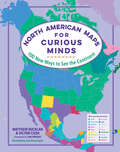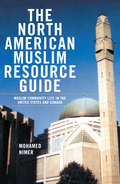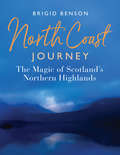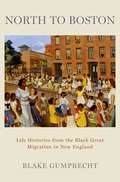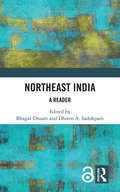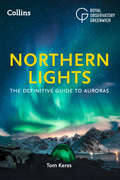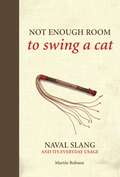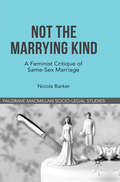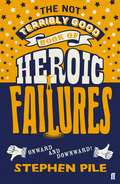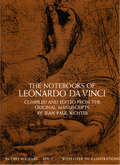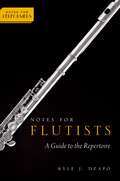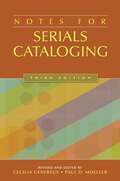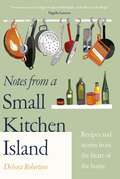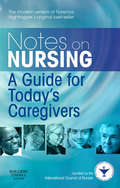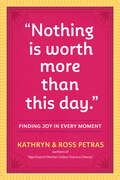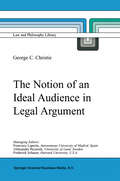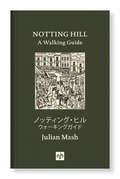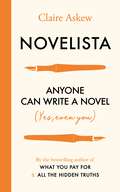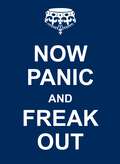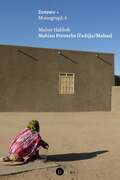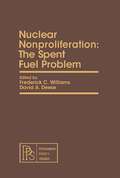- Table View
- List View
North American Maps for Curious Minds: 100 New Ways to See the Continent
by Matthew Bucklan Victor CizekThe Maps for Curious Minds series is back—with 100 vivid infographic maps that transform the way we understand the cultural and geographical wonders of North America No matter how well you think you know North America, the 100 infographic maps in this singular atlas uncover a trove of fresh wonders that make the continent seem like the center of the universe. Did you know that North America is where the first T. rex was found? Or that it&’s where you can visit the world&’s biggest geode as well as its oldest, tallest, and largest trees—not to mention the world&’s tallest and steepest roller coasters?! Brimming with fascinating insight (Who is the highest-paid public employee in each state?) and whimsical discovery (Where can you visit the world&’s largest island in a lake on an island in a lake on an island?), this book highlights the unexpected contours of geography, history, nature, politics, and culture, revealing new ways to see North America—and the hundreds of millions who call it home.
The North American Muslim Resource Guide: Muslim Community Life in the United States and Canada
by Mohamed NimerThis useful resource provides basic information about Islamic life in the United States. Coverage includes population statistics and analysis, as well as immigration information that tracks the settlement of Islamic people in the America. The guide contains contact information for mosques, community organizations, schools, women's groups, media, and student groups. Recent Islamic-American events over the past five years are also reviewed.To see the Introduction, the table of contents, a generous selection of sample pages, and more, visit the The North American Muslim Resource Guide website.
The North American Muslim Resource Guide: Muslim Community Life in the United States and Canada
by Mohamed NimerThis useful resource provides basic information about Islamic life in the United States. Coverage includes population statistics and analysis, as well as immigration information that tracks the settlement of Islamic people in the America. The guide contains contact information for mosques, community organizations, schools, women's groups, media, and student groups. Recent Islamic-American events over the past five years are also reviewed.To see the Introduction, the table of contents, a generous selection of sample pages, and more, visit the The North American Muslim Resource Guide website.
North Coast Journey: The Magic of Scotland’s Northern Highlands - As seen on Jeremy Clarkson's 'Grand Tour'
by Brigid BensonThis is the essential guide to the north of Scotland, on a route which begins in Inverness, weaves westwards to Applecross and then northwards towards Torridon. From Ullapool it leads to the most northerly points in Britain, passing by Caithness and John o’ Groats before heading south again through Dingwall and to Inverness.In addition to stunning mountains, moors, lochs and beaches, the route also featuresexquisite towns and villages, castles, distilleries, breweries, natural wonders and wildlife.Brigid Benson, who knows the road intimately, divides the route into manageable chunks, suggesting where to discover history, observe wildlife, meet great local characters, shop at quirky stores, taste outstanding food, drink in friendly bars and cafes, stand in awe of amazing sights, and recommending places to picnic, swim, surf, walk and stargaze. And great places to camp and stay. She also draws attention to attention to potential pitfalls, offering useful advice on single-track roads, fuel, car problems, planning realistic itineraries, and much more.
North to Boston: Life Histories from the Black Great Migration in New England
by Blake GumprechtBetween World War II and 1980, tens of thousands of Black people moved to Boston from the South as part of the Great Migration, one of the most consequential mass movements of people in American history. Black migration from the South transformed the city, as it did urban areas across the country. North to Boston is the first book to examine that important subject. Blake Gumprecht traces the history of this migration and explores its impacts in greater depth through the lives of ten individuals, each the subject of one chapter. Those chapters are short biographies based on extensive interviews by the author and are told in an engaging style that reflects the author's background as a journalist. The ten people featured came from six southern states. They fled racism, limited opportunity, and hopelessness, and moved north in pursuit of better jobs, equal treatment, and greater freedom. They settled in neighborhoods such as Roxbury, Dorchester, and Mattapan. They worked as teachers, factory workers, welders, and security guards. Their stories are emblematic of the experiences of Black people everywhere who left the South, and provide a rare glimpse into the lives of ordinary people living in one city's Black community. North to Boston brings to life the history of the Great Migration, revealing a hidden aspect of New England's history and shining a spotlight on a singularly important event in the making of Black Boston.
North to Boston: Life Histories from the Black Great Migration in New England
by Blake GumprechtBetween World War II and 1980, tens of thousands of Black people moved to Boston from the South as part of the Great Migration, one of the most consequential mass movements of people in American history. Black migration from the South transformed the city, as it did urban areas across the country. North to Boston is the first book to examine that important subject. Blake Gumprecht traces the history of this migration and explores its impacts in greater depth through the lives of ten individuals, each the subject of one chapter. Those chapters are short biographies based on extensive interviews by the author and are told in an engaging style that reflects the author's background as a journalist. The ten people featured came from six southern states. They fled racism, limited opportunity, and hopelessness, and moved north in pursuit of better jobs, equal treatment, and greater freedom. They settled in neighborhoods such as Roxbury, Dorchester, and Mattapan. They worked as teachers, factory workers, welders, and security guards. Their stories are emblematic of the experiences of Black people everywhere who left the South, and provide a rare glimpse into the lives of ordinary people living in one city's Black community. North to Boston brings to life the history of the Great Migration, revealing a hidden aspect of New England's history and shining a spotlight on a singularly important event in the making of Black Boston.
Northeast India: A Reader
by Bhagat Oinam Dhiren A. SadokpamNortheast India is a multifaceted and dynamic region that is constantly in focus because of its fragile political landscape characterized by endemic violence and conflicts. One of the first of its kind, this reader on Northeast India examines myriad aspects of the region – its people and its linguistic and cultural diversity. The chapters here highlight the key issues confronted by the Northeast in recent times: its history, politics, economy, gender equations, migration, ethnicity, literature and traditional performative practices. The book presents interlinkages between a range of socio-cultural issues and armed political violence while covering topics such as federalism, nationality, population, migration and social change. It discusses debates on development with a view to comprehensive policies and state intervention. With its a nuanced and wide-ranging overview, this volume makes new contributions to understanding a region that is critical to the future of South Asian geopolitics. The book will be of great interest to scholars and researchers of contemporary Northeast India as well as history, political science, area studies, international relations, sociology and social anthropology. It will also appeal to those interested in public administration, regional literature, cultural studies, population studies, development studies and economics.
Northeast India: A Reader
by Bhagat Oinam Dhiren A. SadokpamNortheast India is a multifaceted and dynamic region that is constantly in focus because of its fragile political landscape characterized by endemic violence and conflicts. One of the first of its kind, this reader on Northeast India examines myriad aspects of the region – its people and its linguistic and cultural diversity. The chapters here highlight the key issues confronted by the Northeast in recent times: its history, politics, economy, gender equations, migration, ethnicity, literature and traditional performative practices. The book presents interlinkages between a range of socio-cultural issues and armed political violence while covering topics such as federalism, nationality, population, migration and social change. It discusses debates on development with a view to comprehensive policies and state intervention. With its a nuanced and wide-ranging overview, this volume makes new contributions to understanding a region that is critical to the future of South Asian geopolitics. The book will be of great interest to scholars and researchers of contemporary Northeast India as well as history, political science, area studies, international relations, sociology and social anthropology. It will also appeal to those interested in public administration, regional literature, cultural studies, population studies, development studies and economics.
Northern Lights: The Definitive Guide To Auroras
by Tom Kerss Royal Observatory Greenwich Collins AstronomyDiscover the incomparable beauty of the Northern Lights with this accessible guide for aspiring astronomers and seasoned night sky observers. Covers the essential equipment needed for observation and photography and full of stunning photographs.
Not Enough Room to Swing a Cat: Naval slang and its everyday usage
by Martin RobsonAs the crow flies'', ''chunder'', ''cold enough to freeze the balls off a brass monkey'', ''three sheets to the wind'' - many terms like these are used in everyday English language conversation and writing. But how many landlubbers know that they derive from naval slang or know what the phrase originally referred to? The navy has helped to shape modern society. The navy is famous for its traditions, quirks and nuances. It is disinctly different to wider society and nowhere is this more evident than in language. The naval community once had its own language, incomprehensible to anyone who was not a sailor, which described and explained his unique world. But on shore leave these men introduced their language to the populations of bustling ports and harbours and the usage slowly spread inland. Today through the mediums of film, television and music, naval slang has been brought to the wider public and has become fully integrated into the English language to point where many phrases are used by people who have no concept of their meaning. Presenting terminology thematically, this book provides a compilation of naval slang throughout the world, from terms relating to ship-handling and seamanship through to food and drink, discipline and insults. The text is further enhanced with original black line drawings that illustrate certain technical terms, such as ''splice the mainbrace''.
Not The Marrying Kind: A Feminist Critique of Same-Sex Marriage (Palgrave Socio-Legal Studies)
by N. BarkerNot the Marrying Kind is a new and comprehensive exploration of the contemporary same-sex marriage debates in several jurisdictions including Australia, Canada, South Africa, the United Kingdom and the United States. It departs from much of the existing scholarship on same-sex marriage, which argues either for or against marriage for same-sex couples. Instead, this book begins from a critical analysis of the institution of marriage itself (as well as separate forms of relationship recognition, such as civil partnership, PaCS, domestic partnership) and asks whether and how feminist critiques of marriage might be applied specifically to same-sex marriage. In doing this, the author combines the theories of second wave feminism with insights from contemporary queer theory.
The Not Terribly Good Book of Heroic Failures: An intrepid selection from the original volumes
by Stephen PileLast year Stephen Pile attempted to deliver a daring blow to the success ethic that so pervades Western culture. To his dismay, The Ultimate Book of Heroic Failures sold many copies and even became the Sunday Times 'Humour Book of the Year.'Nothing daunted, Stephen returns with a new selection which brings together the very best of his original classic titles - The Book of Heroic Failures and The Return of Heroic Failures.The heartwarming news that stays news is that there really is no limit to what humanity can achieve, as we move onwards and downwards to ever more immortal and breathtaking feats of incompetence. The Not Terribly Good Book of Heroic Failures lovingly chronicles the all-time heroes who have been so bad at things that they shine as beacons for future generations.It is hard not to feel boundless admiration, for example, for the fifty Mexican convicts who dug an escape tunnel out of their jail and came up in the courtroom where many of them had been sentenced. Or for the world's worst tourist, who spent three days in New York believing he was in Rome.
The Notebooks of Leonardo da Vinci, Vol. 1 (Dover Fine Art, History of Art #1)
by Leonardo Da VinciScientist, painter, mechanical engineer, sculptor, thinker, city planner, storyteller, musician, architect — Leonardo da Vinci, builder of the first flying machine, was one of the great universal geniuses of Western civilization. His voluminous notebooks, the great storehouse of his theories and discoveries, are presented here in 1566 extracts that reveal the full range of Leonardo's versatile interest: all the important writings on painting, sculpture, architecture, anatomy, astronomy, geography, topography, and other fields are included, in both Italian and English, with 186 plates of manuscript pages and many other drawings reproduced in facsimile size.The first volume, which contains all of Leonardo's writings on aspects of painting, includes discussions of such basic scientific areas as the structure of the eye and vision, perspective, the science of light and shade, the perspective of disappearance, theory of color, perspective of color, proportions and movements of the human figure, botany for painters, and the elements of landscape painting. A section on the practice of painting includes moral precepts for painters and writings on composition, materials, and the philosophy of art. The second volume contains writings on sculpture, architecture (plans for towns, streets, and canals, churches, palaces, castles, and villas, theoretical writings on arches, domes, fissures, etc.), zoology, physiology (including his amazingly accurate theories of blood circulation), medicine, astronomy, geography (including has famous writings and drawings on the movement of water), topography (observations in Italy, France, and other areas), naval warfare, swimming, theory of flying machines, mining, music, and other topics.A selection of philosophical maxims, morals, polemics, fables, jests, studies in the lives and habits of animals, tales, and prophecies display Leonardo's abilities as a writer and scholar. The second volume also contains some letters, personal records, inventories, and accounts, and concludes with Leonardo's will. The drawings include sketches and studies for some of Leonardo's greatest works of art — The Last Supper, the lost Battle of Anghiari, The Virgin of the Rocks, and the destroyed Sforza monument.
Notes for Flutists: A Guide to the Repertoire (Notes for Performers)
by Dr. Kyle DzapoNotes for Flutists: A Guide to the Repertoire offers important historical and analytical information about three dozen of the best-known pieces written for the instrument. Its contextual and theoretical insights make it an essential resource for professional, amateur, and student flutists. With engaging prose supported by fact-filled analytical charts, the book offers rich biographical information and informative analyses to help flutists gain a more complete understanding of J. S. Bach's Sonata in B minor, Reinecke's Undine Sonata, Fauré's Fantaisie, Hindemith's Sonata for Flute and Piano, Copland's Duo for Flute and Piano, and 30 other masterpieces. Offering a faithful and comprehensive guide to understanding the contexts in which the repertoire was composed, Notes for Flutists details in clear, chronological order flute repertoire from Telemann, Mozart, and Enescu to Prokofiev, Poulenc, and Muczynski. Kyle Dzapo includes biographical information on each composer and highlights history's impact on the creation and performance of important works for flute. Intended as a starting point for connecting performance studies with scholarship, Dr. Dzapo's analysis will help flutists gain a more complete picture of a given work. Its valuable insights make it essential to musicians preparing and presenting programs, and its detailed historical information about the work and composer will encourage readers to explore other works in a similarly analytical way. Covering concertos, chamber pieces, and works for solo flute, Kyle Dzapo presents Notes for Flutists, an indispensable handbook for students and professionals alike.
Notes for Flutists: A Guide to the Repertoire (Notes for Performers)
by Dr. Kyle DzapoNotes for Flutists: A Guide to the Repertoire offers important historical and analytical information about three dozen of the best-known pieces written for the instrument. Its contextual and theoretical insights make it an essential resource for professional, amateur, and student flutists. With engaging prose supported by fact-filled analytical charts, the book offers rich biographical information and informative analyses to help flutists gain a more complete understanding of J. S. Bach's Sonata in B minor, Reinecke's Undine Sonata, Fauré's Fantaisie, Hindemith's Sonata for Flute and Piano, Copland's Duo for Flute and Piano, and 30 other masterpieces. Offering a faithful and comprehensive guide to understanding the contexts in which the repertoire was composed, Notes for Flutists details in clear, chronological order flute repertoire from Telemann, Mozart, and Enescu to Prokofiev, Poulenc, and Muczynski. Kyle Dzapo includes biographical information on each composer and highlights history's impact on the creation and performance of important works for flute. Intended as a starting point for connecting performance studies with scholarship, Dr. Dzapo's analysis will help flutists gain a more complete picture of a given work. Its valuable insights make it essential to musicians preparing and presenting programs, and its detailed historical information about the work and composer will encourage readers to explore other works in a similarly analytical way. Covering concertos, chamber pieces, and works for solo flute, Kyle Dzapo presents Notes for Flutists, an indispensable handbook for students and professionals alike.
Notes for Serials Cataloging
The last decade has brought a great deal of change to serials and to scholarly communication as a whole. Serials have gone online or online only with a rapidness few expected; and many libraries now spend half or more of their materials budgets on electronic journals. Arranged in MARC tag order and by topical subdivision, the latest edition of Notes for Serials Cataloging is designed to help both novice and experienced serials catalogers describe the complex characteristics and relationships of serial publications and construct clear and concise notes. In addition to updated definitions, scope notes, and examples of notes presented in previous editions, it incorporates notes used in electronic serials cataloging as well as covers changing practices in MARC note field usage in keeping with CONSER standards.
Notes from a Small Kitchen Island: ‘I want to eat every single recipe in this book’ Nigella Lawson
by Debora RobertsonDiscover the cookbook you'll never want to live without, filled with the secrets to creating delicious home-cooked meals every single day'I am so greedily impatient for this book. I want to read it. I want to cook from it' NIGELLA LAWSON'There are wonderful tales and recipes here, and lots of wisdom. It's approachable, anchored in real life and a joy to read. I want more' DIANA HENRY'A wonderful book full of inspiring, simple and time-saving recipes. This should be an everyday book for everybody' TOM KERRIDGE_________Debora Robertson, home cook and renowned food writer, tells how, from the least promising of culinary starts, she learned to love cooking and transformed her cosy kitchen into the beating heart of her home.Through her stories and recipes, she will whisk you away to hot summers in Languedoc and balmy weeknights in London, revealing the life-changing dishes that made her. Bound together with life- and dinner-saving lessons, Debora has written the essential kitchen companion for every home cook.From the tastes of Debora's childhood to the recipes she discovered on her travels, to the food she cooks every day . . .· Leek and ham hock steamed pudding· Slow roast lamb with Durham salad· Meemaw's Texan margarita pie· The best recipe for roast chicken· Delicious plum cakeDebora will take you by the hand and tell you everything you'll ever need to know about cooking food you'll love time and time again._________ 'I want to eat every single recipe in this book - even the two for dogs!' NIGELLA LAWSON
Notes on Nursing E-Book: A Guide for Today's Caregivers
by Linda Carrier-WalkerFlorence Nightingale wrote 'Notes on Nursing' for caregivers in the home and it is remarkable how much of the original remains relevant today. This modern edition aims to complement the work of Florence Nightingale, extending her reach to new generations committed to caring for the people they love. The International Council of Nurses and the Florence Nightingale International Foundation (FNIF) have prepared this modern edition of the Notes 150 years after its original publication, to mark FNIF’s 75th anniversary. Practical advice on what a caregiver needs to do and know in order to deliver the best care to loved ones, including how to organise the home environment, preparing and serving food, bedding and preventive measures against infection and other complications which put loved ones at risk.. Clear guidance, with illustrations, lists and planning tools to help caregivers organize and provide an effective program of care. Advice for caregivers on how to work with nurses, physicians and other health professionals to ensure their prescriptions and advice are well understood and implemented. Advice which anticipates and addresses the needs of all caregivers, whether they live in a modern community or in remote regions with less access to safe water, medications and health professionals. Adds new information and advice based on current medical knowledge, while retaining segments of the original work that remain relevant today Provides common-sense guidance on good hygiene and organization for caregivers worldwide, whatever their material circumstances Endorsed by the IAPO (International Alliance of Patients' Organizations
"Nothing Is Worth More Than This Day.": Finding Joy in Every Moment
by Kathryn Petras Ross PetrasA book of inspirational quotations, Nothing Is Worth More Than This Day presents hundreds of reminders from some of the smartest people who ever lived—from Dr. Seuss to Erma Bombeck, Thich Nhat Hanh to Lena Dunham—that happiness is everywhere and the glass is half-full. It&’s the perfect gift of optimism, for good times and not-so-good times.
The Notion of an Ideal Audience in Legal Argument (Law and Philosophy Library #45)
by George ChristieAs the dedication ofthis book suggests, the genesis ofthis book arises from my association with Cha'im Perelman. Because I was one of the few Americans to comment on his TraUe de l' argumentation: la nouvelle rhetorique, before it was translated into English, I was invited to a conference celebrating the translation ofthat monumental work into English that was held in August 1970 in Santa Barbara, Califomia at the Center for the Study ofDemocratic Institutions, which was then under the directorship of the late Robert M. Hutchins. From that beginning, Professor Perelman and I developed a strong and warm friendship which was cemented when Professor Perelman and his wife, Fela, came to North Carolina in 1979 as a fellow at the National Humanities Center. I enjoyed the occasions on which I was able to participate in the activities of the Centre National de Recherehes de Logique which had been established, under Professor Perelman's aegis, in Belgium. A trip to Brussels was always something to which I looked forward. Since Professor Perelman's sudden and untimely death in January 1984, shortly after he had been singularly honored by being made a baron by King Baudouin, I have benefited greatly from my participation in the programs of the Perelman Foundation which was established through the generosity and efforts ofBaronne Fela Perelman; a remarkable woman in her own right who has now sadly also passed away.
NOTTING HILL: A Walking Guide
by Julian MashThis bilingual guide to Notting Hill and Portobello Road is designed to take the curious wanderer through one of London's most bohemian districts. Through four themed walks, Julian Mash uncovers the history, culture, and little-known facts about this unique area. Featured photographs and hand-drawn maps, and a curated Directory of special places to visit, this is an essential handbook for visitors and residents alike.
Novelista: Anyone can write a novel. Yes, even you.
by Claire AskewNOVELISTA is a friendly, straight-talking writing guide for people who want to write a novel but don't know how to begin. It asks all the important questions and gives a host of reassuring answers that demonstrate that anyone can write a novel - even you!To begin with, what the hell is a novel? It's basically a tiny world, where characters are born, live, and (sometimes) die. To write one all you need is a notebook and a pen - but along the way you'll want to learn about good writing habits, planning, mastering descriptions and dialogue and how to pull it all together. This book will guide you through the process and orient you towards the goal of publication.From absolute beginner to novelista, this book will change the way you write and think about writing.
Now Panic and Freak Out
by Summersdale PublishersKeep Calm and Carry On is all very well, but life just isn't that simple. Let's own up and face facts: we're getting older, the politicians are not getting any wiser, and the world's going to hell in a handbasket. It's time to panic. Here's a book packed with quotations proving that Keeping Calm is simply not an option.
Nubian Proverbs (Fadijja/Mahas)
by Maher HabbobIn the 1995/96 academic year, twenty-five Egyptian Nubian students of the Faculty of Social Work in Aswan were recruited by Dr. Muddathir Salim to complete a brief Nubian ethnological survey, largely restricted to the area of New Nubia, over a period of several months. They documented Egyptian Nubian culture and heritage, among them proverbs, tales, lullabies, marriage customs, and moulid and mourning songs, as well as models of Nubian clothes, jewelry, and houses. This research has culminated in Maher Habbob's Nubian Proverbs, which presents the fruits of decades of collecting proverbs from his native Nubian region in Fadijja (Nobiin). The five hundred proverbs gathered in this volume give a vivid picture of the Nubian imagination and represent a priceless archive of cultural heritage threatened by ongoing assimilation and cultural genocide. The proverbs are presented in Nubian script, accompanied by a transliteration in Roman script, an a literal translation and paraphrase in English.
Nuclear Nonproliferation: The Spent Fuel Problem
by Frederick C. Williams, David A. DeeseNuclear Nonproliferation: The Spent Fuel Problem examines the debate concerning the storage of spent fuel generated by nuclear reactors and its implications for nuclear nonproliferation efforts. Potential barriers to the establishment or expansion of national storage facilities for spent fuel are discussed, along with alternatives. This book covers a broad spectrum of possible multinational and international arrangements for spent fuel management, ranging from relatively benign international oversight of national facilities to arrangements for bilateral and regional cooperation, and even the creation of entirely new international institutional mechanisms. The technical, economic, political, and legal aspects of managing spent fuel are explored, paying particular attention to Eastern Europe, Western Europe, the Indian Ocean Basin, Asia, the Middle East, and Latin America. Public attitudes toward nuclear energy, especially with regard to the issue of radioactive waste disposal, are also considered. The final chapter looks at the political aspects of nuclear nonproliferation in general and of spent fuel management in particular. This monograph will be of interest to government officials and policymakers concerned with nuclear energy and nonproliferation.
